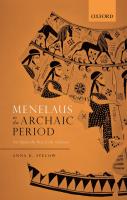
OUP (2020) h/b 376pp £85.00 (ISBN 9780199685929)
‘To be as gallant as possible, one might call Menelaus the perennial second best.’ This quotation from Norman Austin not only opens S.’s stimulating and enticing book but serves as a goad to propel its intriguing investigations. At first sight Austin’s analysis seems uncontroversial. Homer’s Menelaus is indeed overshadowed by others. He is, after all, the cuckolded husband of Helen, second-in-command to his brother, Agamemnon, a less terrifying fighter, and certainly a less romantic hero than either Hector or Achilles. Nor has the lens of later literature enhanced our view of Menelaus. Imperial Athenians portrayed this representative of rival Sparta in an unflattering light, and subsequent generations tended to follow their example—until now.
Drawing on an impressively wide range of materials and delving deep into the Homeric epics, the Epic Cycle, the lyric poetry of Alcman, Sappho and Stesichorus, archaic vase painting, the archaeology of the Menelaion at Therapne above Sparta, and the Plataea Elegy of Simonides, S. coaxes from the shadows a more nuanced and rounded vision of Menelaus than we are used to. Appraising his Homeric epithets and scrutinizing both intratextual allusions and intertexual echoes (of not just the Epic Cycle but possible earlier lost poems, whose existence would explain certain Homeric anomalies), she reveals him as a ‘personality’ committed to ‘“oath-keeping”, “justice”, and “adherence to the will of Zeus”’, a decent, clement man, who abhors conflict between friends, a pious hero who well deserves the immortality which he is promised in his encounter with the shape-shifting Proteus. This immortality is perhaps suggested throughout the epics by his epithet xanthos, and where S. translates she is assiduous in teasing out possible meanings, questioning, for example, whether by calling Menelaus ‘[to]n andra ton [… ar]iston’ Sappho means he is the best of men or simply the richest. S. is equally compelling in her study of vase painting and archaeology. Iconography of archaic scenes showing Menelaus dueling or retrieving Helen at Troy further reveals him as an heroic rather than potentially comedic figure, while his cult at Therapne, albeit shared with Helen, confirms his historical Spartan status as a demigod, the equal of the Dioscuri, beside whom, Simonides suggested, he (not his brother, Agamemnon) fought for the Greeks at Plataea.
In short, this essential volume (with 19 black-and-white illustrations, full footnotes, a good bibliography and an index locorum and a general index) makes manifest not only Menelaus’ well-developed character but the sheer sophistication of the art and poetry of Archaic Greece. However, it is not for everyone. S. has based it on her dissertation at the University of Minnesota, and general readers may find some passages hard to navigate, especially since none of the French or German quotations and not all the Greek are translated. Perhaps she might be persuaded to write a more populist or student-friendly version. For her thesis deserves wider dissemination and, while she cannot quite shake off Austin’s damnation of Menelaus as ‘second best’, she does prove that he is perennial. As she points out, ‘Not only is Menelaus the only Achaean hero in extant archaic literature to end his life in Elysium; he is also the only one in Homer to be granted immortality.’ Should Homer be correct, and should Menelaus be inclined to order Hermes to deliver him a copy of this book, the great hero would find much in it to swell his heart.
David Stuttard
